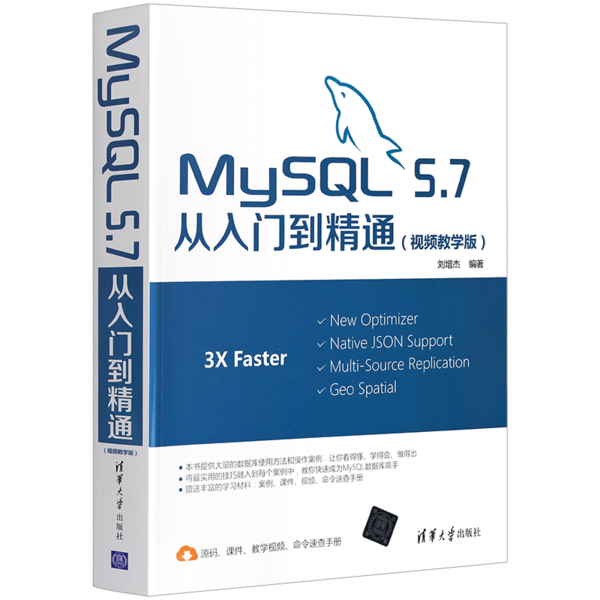本文主要给大家简单讲讲常用的一些mysql语句及用法,相关专业术语大家可以上网查查或者找一些相关书籍补充一下,这里就不涉猎了,我们就直奔主题吧,希望常用的一些mysql语句及用法这篇文章可以给大家带来一些实际帮助。
1.开启mysql数据库服务
格式: net start mysql
如: net start mysql57
2.关闭mysql数据库服务
格式: net stop mysql
如: net stop mysql57
3.登陆mysql服务
格式: mysql -u root -p
如: mysql -u root -p 执行成功后,在输入密码,
4. 查看当前数据库的版本xinxi
格式: select version();
5.查看当前时间
格式: select now();
6.退出,
quit,exit
2.数据库database的操作
1.查看当前有哪些数据库
格式: show databases;
2.创建一个数据库
格式: create database 数据库名 charset=utf8;
例: create database wen charset=utf8;
3.删除一个数据库
格式: drop database 数据库名;
例: drop database wen;
4.使用数据库
格式:use 数据库名;
例: use wen;
5.查看当前使用数据库
格式: select database();
3.表table的操作
1.查看当前数据库有哪些表
格式: show tables;
2.创建一个表
格式: create table 表名(字段名及类型);
例: create table student(id int auto_increment primary key,name varchar(20) not null,age int not null,address varchar(20),gender bit default 1);
3.查看表的结构
格式: desc 表名;
例: desc student;
4.查看创建表的语句
格式: show create table 表名;
5.删除表
格式: drop table 表名;
例: drop table student;
6.修改表
1.修改表的名字
格式: rename table 旧表名 to 新表名;
例: rename table student to students;
2.修改表的结构, add | drop | change
1.add 添加一个新的字段
格式: alter table 表名 add 字段名 类型;
例: alter table student add phone int;
2.change 修改
格式: alter table 表名 change 旧字段名 新字段名 新字段类型;
例: alter table student change phone number varchar(20);
3.drop 删除
格式: alter table 表名 drop 字段名;
例: alter table student drop number;
4.数据的操作
1.插入数据
1.插入全列数据
格式: insert into 表名 values(值1,值2,....)
注意:值得顺序需要与表的结构对应, 主健可以写0
例: insert into student values(0,"小明",36,"北京朝阳区",1);
2.缺省插入
格式:insert into 表名(字段名1,字段名2,....) values(值1,值2,....)
例: insert into student(name,age,address) values("小东",48,"深圳南山区");
3.插入多条数据
格式: insert into 表名 values(值1,值2,....),(值1,值2,....),(值1,值2,..)
例: insert into student values(0,"小云",45,"杭州",0),(0,"小雨",105,"俄罗斯",0),(0,"小清",99,"日本",0);
2.删除数据
格式: delete from 表名 where 条件
例: delete from student where age = 105;
delete from student
不加条件表示全部删除, 请谨慎使用
3.修改数据
格式:update 表名 set 字段名1=值,字段名2=值,... where 条件;
update student set gender = 1 where name = "小青";
update student set age = 52,address="深圳" where name = "小东";
4.查看所有数据
格式: select * from 表名;
例: select * from student;
5.查询数据
1.查询格式
1.查询所有
格式: select * from 表名;
2.按条件查询
格式: select 字段名1,字段名2,... from 表名 where 条件;
1.select后跟的是查询结果需要显示的字段名
2. * 表示所有的字段名都要显示
3. from 后跟的是表名,表示从那个表查
4. where 后跟的是筛选条件
5. 可以使用 字段名 as 别名 来给字段名取个别名
例: 显示 name和age
select name,age from student;
select name as "姓名" from student;
2.条件中的运算
1.比较运算符
> 大于
< 小于
>= 大于等于
<= 小于等于
= 等于
!= 不等于
格式: select 字段名1,字段名2,... from 表名 where 字段名 比较运算符 值;
例: select * from student where age < 50;
2. 逻辑运算符
and 且
or 或者
not 非
格式: select 字段名1,字段名2,... from 表名 where 字段名 比较运算符 值 逻辑运算符 字段名 比较运算符 值 ...;
例: select * from student where age < 50 and age > 40;
select * from student where not (age < 50 and age > 40);
3.模糊运算符 like
% 表示多个任意字符
_ 表示一个任意字符
需求: 匹配所有姓小的人
格式: select * from student where name like "小%";
格式: select * from student where name like "小_";
需求: 匹配名字中有 "小"字的
select * from student where name like "%小%";
4.范围查询
in (多个值 ) 判断一个值 是否是多个值中的一个
between 值1(包含) and 值2(包含) 判断一个值是否在 值1与值2之间
格式: select 字段名1,字段名2,... from 表名 where 字段名 范围运算符 值;
例: 找出 25或者45或者80或者 90
select * from student where age in (25,45,80,90);
需求:找出25 到 45之间的数据
select * from student where age between 25 and 45;
5. 空判断
is null 为空
is not null 不为空
格式: select 字段名1,字段名2,... from 表名 where 字段名 is null;
插入数据: insert into student(name,age) values("小·超",60);
例: select * from student where address is null;
select * from student where address is not null;
6.去除重复的值
格式: select distinct 字段名 from 表名 where 条件;
例: select distinct gender from student;
7.聚合函数
count(*) 求当前结果总共有多少条数据
sum(列名) 求列名对应列的 和
avg(列名) 求当前列的平均值
max(列名) 求当前列的最大值
min(列名) 求当前列的最小值
例: 求当前表总共有多少条数据?
select count(*) from student;
求年龄最小的?
select min(age) from student;
8.分组 group by
格式: select 字段名... from 表名 where 条件 group by 字段名
查看有多少种性别
例: select gender from student group by gender;
需求:统计 男生 和 女生 各有多少个
select gender,count(*) from student group by gender;
需求: 统计所有女生的个数?
例: select gender,count(*) from student group by gender having gender = 1;
where 查询条件, 是先执行的查询条件
having 查询条件 是在查询结果的基础上在查询
9. 排序
格式: select 字段名... from 表名 where 条件 order by 字段名1,字段名2...
例: 年龄小到大
select * from student order by age;
默认是从小到大排列
asc 从小到大
desc 从大到小
select * from student order by age asc
10. 分页
格式: select 字段名... from 表名 where 条件 limit 起始值,多少条数据
起始值可以从 0 开始
例: select * from student limit 0,3;
常用的一些mysql语句及用法就先给大家讲到这里,对于其它相关问题大家想要了解的可以持续关注我们的行业资讯。我们的板块内容每天都会捕捉一些行业新闻及专业知识分享给大家的。
亿速云「云数据库 MySQL」免部署即开即用,比自行安装部署数据库高出1倍以上的性能,双节点冗余防止单节点故障,数据自动定期备份随时恢复。点击查看>>
免责声明:本站发布的内容(图片、视频和文字)以原创、转载和分享为主,文章观点不代表本网站立场,如果涉及侵权请联系站长邮箱:is@yisu.com进行举报,并提供相关证据,一经查实,将立刻删除涉嫌侵权内容。